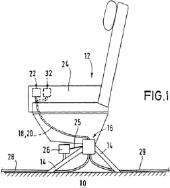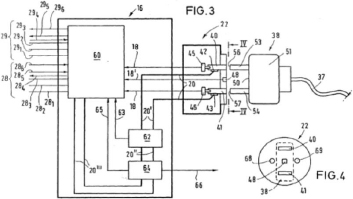Lufthansa Technik AG (a company incorporated in Germany) v Astronics Advanced Electronics Systems (a company incorporated in the state of Washington, USA)
| Jurisdiction | England & Wales |
| Judge | Lord Justice Moylan,Sir Nicholas Patten,Lord Justice Birss |
| Judgment Date | 14 January 2022 |
| Neutral Citation | [2022] EWCA Civ 20 |
| Docket Number | Case No: A3/2020/1535 |
| Year | 2022 |
| Court | Court of Appeal (Civil Division) |
[2022] EWCA Civ 20
IN THE COURT OF APPEAL (CIVIL DIVISION)
ON APPEAL FROM HIGH COURT CHANCERY DIVISION
The Honourable Mr Justice Morgan (Sitting as a Judge of the Patents Court)
HP-2017-000085 / HP-2019-000019
Royal Courts of Justice
Strand, London, WC2A 2LL
Lord Justice Moylan
Lord Justice Birss
and
Sir Nicholas Patten
Case No: A3/2020/1535
&
&
Piers Acland QC & Stuart Baran (instructed by Hogan Lovells International LLP) for the Appellants
Hugo Cuddigan QC & Christopher Hall (instructed by Jones Day) for the Respondent
Hearing dates: 3 & 4 November 2021
Approved Judgment
This appeal relates to the judgment of Morgan J on 22 July 2020 ( [2020] EWHC 1968 (Pat)), in which he held that European Patent (UK) 0 881 145 B1 (“Electrical Power Supply Device”) was valid and was infringed by the defendants' products. The patent belongs to Lufthansa Technik AG. The defendants are Astronics Advanced Electronic Systems, Safran Seats GB Limited and Panasonic Avionics Corporation.
The patent was granted on 26 November 2003 claiming a priority date of 31 May 1997. It expired on 22 May 2018. The specification of the granted patent was in German. The case has used an English translation for all purposes and no issue arises in relation to that translation.
The defendants sought permission to appeal on construction and on the validity of claims 1 and 2. Permission was granted by Arnold LJ on certain grounds and the application for permission on one ground was adjourned to this hearing (novelty of claim 1). The issues arising on appeal concern claim construction and validity only. There is no issue about infringement. The appellants also made an application for permission to introduce a new ground of appeal, to challenge the validity of claim 3.
There were two actions before Morgan J. They have been tried and heard together below and on appeal. In one the claim by Lufthansa is against Astronics and Safran and in the other the defendant is Panasonic.
The invention is concerned with the provision of high-voltage AC electrical power inside an aircraft for a passenger's electronic device. Figure 1 of the patent is as follows:

The power is delivered via a socket, such as item 22 shown in the arm rest of the passenger seat, and a power supply device, such as item 16 shown under the seat in the figure. Figures 3 and 4 are as follows:

Fig 3 shows a power supply device (item 16), a socket (item 22) and a plug (item 38). Fig 4 depicts an alternative socket which can accommodate two kinds of plug.
Claim 1 is as follows:
A voltage supply apparatus for providing a supply voltage for electric devices (36) in an aeroplane cabin, comprising
a socket (22) to which the device (36) is connectable by means of a plug (38) and to which the supply voltage can be applied,
the socket (22) comprising a socket detector (45, 46, 48) detecting the presence of a plug (38) inserted in the socket (22), and
a supply device (16) being provided remotely from the socket (22) and being connected to the socket (22) via a signal line (18) and via a supply line (20) for the supply voltage,
the supply device (16) applying the supply voltage to the socket (22) when the plug detectors (45, 46, 48) indicate the presence of the plug (38) via the signal line (18) to the supply device (16)
characterized in that
the plug detector (45, 46) is formed such as to detect the presence of two contact pins (53, 54) of the plug (38) in the socket (22), and
the supply device (16) only applies the supply voltage to the socket (22) if the presence of two contact pins (53, 54) of the plug (38) is detected simultaneously.
The claim is drafted using the EPO's conventional approach of having two portions divided by the words “characterised in that”. By convention the pre-characterising part is based on prior art, in this case a patent called Quintel (FRA 2,653,944). This case highlights a curiosity of the pre/post characterising approach to claim drafting. When drafted this way the characterising features of the claim explain what the patentee thought were features not disclosed in the prior art on which the pre-characterising part was based, i.e. Quintel. In other words these characterising features are presented as representing the inventive step over that prior art. However the challengers to validity in this case, as they are entitled to, rely on different prior art. In response the patentee seeks to identify distinctions over that other prior art. As it turns out in this case those distinctions are features of the pre-characterising part. So the inventive step (if it is one) over the other prior art may very well not be the features in the characterising portion of the claim at all. I mention this only to make the point that it is a legitimate approach for patentees to take. Many good inventions amount to new combinations of old features. The fact that each of the individual features making up a claimed invention can be found in various places in the prior art may well help the party challenging validity to make their case but it does not, on its own, prove that a claim lacks an inventive step.
Claim 1 claims a product rather than a process. It is a voltage supply apparatus. It is suitable for supplying power to electrical devices, such as a laptop computer, in an aeroplane cabin. The apparatus comprises a socket and a supply device which can supply electrical power. The plug of the user's laptop can be plugged into the socket. There is a detector in the socket for detecting the plug. It is called a “socket detector” in this portion of the claim but reading the claim as a whole it is really a plug detector. Nothing turns on that. The supply device is provided remotely from the socket. There are two lines from the socket to the supply device – a signal line and a supply line. The apparatus is set up so that when the plug detector detects a plug it sends a signal on the signal line to the supply device. In response the supply device applies the supply voltage. By contrast, if no plug is plugged in, no signal is sent to the supply device and thus no electrical power is sent to the socket, and the socket is safe.
All of what has been described so far is based on the pre-characterising portion of the claim and the two issues of construction on this appeal both relate to the same pre-characterising portion. The first is about what “inserted in the socket” means and the second is about what “remotely” means. On the first issue, the judge accepted the patentee's case that inserted in the socket means fully inserted (judgment paragraphs 67–79). The appellants contended below and in this court that that is wrong and that a detector which detects a partially inserted plug will do. In relation to “remotely”, the judge also favoured the patentee, holding (paragraphs 80–94) that it means that the supply device has to be kept away from the socket and arranged in such a way that there is no source of danger to the passenger. In reaching this conclusion the judge was rejecting the appellants' case that all that is required is some separation between the supply device and the socket. The appellants contend that the claim just requires the supply device to be “physically separate from” the socket and would include within its scope a set up with the supply device in a separate box located side by side with the socket, for example with both fitted in the arm rest of the passenger seat. I will refer to the two rival cases as “far remote” and “near remote”. The appellants contend for the latter. In reaching the conclusion in favour of “far remote” the judge also rejected the appellants' submission that that construction would render claim 1 invalid for insufficiency (uncertainty). On appeal the appellants maintain their case that “near remote” is the right construction, and their case that if “far remote” is the right construction then the claim is insufficient.
To finish claim 1, the characterising portion introduces two further features. The socket must be formed to detect the presence of two contact pins of the plug, and the apparatus must be set up so that the supply voltage is only supplied if the presence of two contact pins is detected simultaneously. The latter feature means that the two pins must both be present at the same time. Whether they arrive at the same time or one after the other does not matter for claim 1.
Claim 2 is as follows:
2. The voltage supply apparatus according to claim 1, wherein the supply device (16) only applies the supply voltage if a maximum contact time is not exceeded between the detection of the first and the second contact pin (53, 54) of the plug (38).
By setting the maximum contact time to a small period, the system will be able to distinguish between the case in which the two pins arrive together, as they would with a real plug, and a case in which one pin is inserted and then another one, perhaps as a result of a child playing with paper clips.
Claim 3 is as follows:
3. The voltage supply apparatus according to claim 1 or 2, wherein the plug detector comprises mechanical switches (45, 46) activated by the inserted contact pins (53, 54) of the plug (38).
The requirement for the mechanical switches serves as a distinction over an item of prior art called Neuenschwander (see below).
Claims 4 and 5 are:
4. The voltage supply apparatus according to one of claims 1 – 3, wherein the plug (22) comprises a casing detector (48) detecting the presence of the plug casing (51) of the plug (38) at the socket...
To continue reading
Request your trial-
Proceed With Caution: Pre- And Post-Characterising Claims Ahead
...be enough. Not so. In the recent Court of Appeal decision of Lufthansa Technik AG v Astronics Advanced Electronics Systems and ors [2022] EWCA Civ 20 the distinction fell to be considered. In the judgement of LJ Birss, he This case highlights a curiosity of the pre/post characterising appro......
-
Proceed With Caution: Pre- And Post-Characterising Claims Ahead
...be enough. Not so. In the recent Court of Appeal decision of Lufthansa Technik AG v Astronics Advanced Electronics Systems and ors [2022] EWCA Civ 20 the distinction fell to be considered. In the judgement of LJ Birss, he This case highlights a curiosity of the pre/post characterising appro......
-
Pre- And Post-characterising Claims
...be enough. Not so. In the recent Court of Appeal decision of Lufthansa Technik AG v Astronics Advanced Electronics Systems and ors [2022] EWCA Civ 20 the distinction fell to be considered. In the judgement of LJ Birss, he This case highlights a curiosity of the pre/post characterising appro......
-
Pre- And Post-characterising Claims
...be enough. Not so. In the recent Court of Appeal decision of Lufthansa Technik AG v Astronics Advanced Electronics Systems and ors [2022] EWCA Civ 20 the distinction fell to be considered. In the judgement of LJ Birss, he This case highlights a curiosity of the pre/post characterising appro......

